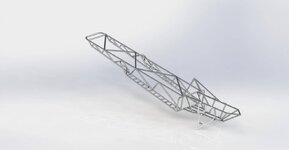L
I have started a tube chassis in Solidworks. I wanted to get a good conceptual design before I start to build one. I have taken most of the measurements from a rev chassis since it is what I have available to me at the moment. So far I have run analysis of weight from aluminum tubing and chromoly in 1/16th wall and 1/8th wall. The chromoly weighs 15 lbs total using 1/16th wall. The aluminum 6061 weighs in at 9 lbs using 1/8th wall. I think I can cut some triangulation out to bring some more weight off.
I am curious if anyone that has built a tube chassis has any input on certain aspects of a tube chassis design. I plan to balance the sled; however, not sure if a perfect balance is what one would want. I am thinking it might be better to have a weight proportion i.e 60/40? The bulkhead isn't quite right yet either. I need a un-assembled bulkhead to take measurements from.
So far this frame is going to require about 100 L.F. of 3/4" tubing. This doesn't include the 10% I would add for *&$% ups such as bad cuts and screwed up bends.
I have included a solidworks rendering of what I have so far.
Looking forward to some input.

I am curious if anyone that has built a tube chassis has any input on certain aspects of a tube chassis design. I plan to balance the sled; however, not sure if a perfect balance is what one would want. I am thinking it might be better to have a weight proportion i.e 60/40? The bulkhead isn't quite right yet either. I need a un-assembled bulkhead to take measurements from.
So far this frame is going to require about 100 L.F. of 3/4" tubing. This doesn't include the 10% I would add for *&$% ups such as bad cuts and screwed up bends.
I have included a solidworks rendering of what I have so far.
Looking forward to some input.

Last edited:


